Transiting Circumbinary Planets in the Era of Space-Based Photometric Surveys
Abstract
1. Introduction
2. Transiting Circumbinary Planets from Kepler and TESS
- •
- Orbital Configuration and Observability The current family portrait of CBPs discovered from Kepler and TESS is shown in Figure 2 in terms of orbital period, distance, planet size, and distance from the critical limit for long-term dynamical stability. As seen from the figure, all except Kepler-1647 b [92]) and KIC 7821010 are very close to their host binary stars—within a factor of two of the critical separation for stability (e.g., [45,49,57])—with Kepler-16 b orbiting just ∼ away from .The stability limit has a direct consequence for the detection of transiting CBPs and is responsible for one of the major observational challenges related to these planets. As highlighted in the left panel of the figure, only one of the planets has an orbital period shorter than 50 days (Kepler-47 b at 49.5 days), and another has an orbital period of about 66.3 days (Kepler-413 b). The rest have orbital periods of hundreds of days, reaching up to nearly four years for the case of Kepler-1647 b. Even if we ignore the complications presented by the above-mentioned aperiodicity and precession-induced missed transits, finding such orbital periods from the ground is exceedingly difficult (even practically impossible). Thus, it is not surprising that the first detection and confirmation of a transiting CBP had to wait for the nearly continuous, years-long observational coverage provided by the Kepler mission.Another major observational challenge is that transiting CBPs do not necessarily transit during every conjunction. Unlike single-star planets that either transit over the course of the observations or do not, CBPs may transit or may not. Due to the orbital precession on relatively short timescales a CBP can produce a complex pattern of potentially sporadic transits. This is highlighted in Figure 3 for the case of Kepler-413 b where the precession period is ∼11 years [85]. Depending on the orbital configuration and dynamical complexity of the system, a CBP can produce transits during non-consecutive conjunctions, start/stop transiting during the observations or even start, then stop, and then start again [52,53,85]. Importantly, this is not a rare occurrence as several CBP systems exhibit this unusual observational signature during observations from both Kepler and TESS, and the known CBPs produce transit during only about ∼5– of all conjunctions (e.g., [23]).It is also important to note that the absence of transits in the lightcurve of an EB does not necessarily correspond to the absence of potential planets as these could simply transit during data gaps (similar to single-star planets) or during stellar eclipses. If a transit is completely blended with an eclipse, i.e., a syzygy, recovering the former would require nearly perfect removal of the former. In fact, to account for this eventuality, every eclipse needs to be carefully removed from the lightcurve as the transit time is a priori unknown. This is a complex and time-consuming effort that requires thorough analysis of the intrinsic variability of both stars and could produce a large number of false positives. If, however, the blend is partial and the signal to noise is sufficient, it might be possible to identify the transit without extensive manipulation of the lightcurve. This is highlighted in Figure 4 for the case of Kepler-1647 b [92].
- •
- CBPs vs. single-star planets: An interesting question to consider is whether the single-star and close-binary-star planets exhibit common characteristics. While addressing this question likely requires a considerably larger sample than 14 planets, a qualitative comparison between the two populations could uncover valuable insights that merit further exploration. Figure 5 illustrates such comparison in terms of the radius, period, and insolation for the confirmed transiting planets around EBs, around single stars (including the Solar System), and around one star in a multistar system (S-type configuration, [44]). Given the associated observational biases, sample sizes and completeness, the CBPs seem to be larger, receive less insolation, and reside on wider orbits.Whether these are representative characteristics of the general CBP population is still unclear, yet there are certain aspects worth considering. While the 12 known CBP systems seem to occupy a distinct parameter space in Figure 5, there are hints of an underlying diversity with regard to their physical and orbital properties. In particular, five systems already stand out from the rest: (i) Kepler-16 due to its proximity to the stability limit (); (ii) Kepler-34 due to its high eccentricity (); (iii) Kepler-47 and TOI-1338 due to their multiplicity (3- and 2-planet systems, respectively); (iv) Kepler-413 due to its rapid orbital precession (precession period of ∼12 years); (v) and Kepler-1647 due to its long orbital period ( days).Four of the transiting CBPs are in the conservative habitable zone [93]. In terms of habitability, CBP are particularly interesting targets as the insolation they receive is far from constant. Instead, it varies on multiple timescales depending on the binary period, the CBP period, and the CBP precession period (e.g., [94,95,96,97,98,99,100,101,102,103], and references therein). The variations can be substantial, even to the point of a CBP moving into and out of the habitable zone during a single planetary orbit. In addition, one has to take into account the insolation contribution from two stars of different spectral types, the response of the atmosphere to the (potentially) rapid variations, the evolution of the stars, and various other factors. Furthermore, binary systems with orbital periods longer than 10 days may in fact be better in terms of habitability prospects compared to single stars as tidal interactions between the stars can decrease chromospheric activity (potentially drastically) that might otherwise be harmful for the emergence and evolution of life [104,105].Additionally, while today we know of thousands of planets outside the solar system, the situation was quite different twenty five years ago. At the time, the sample was much smaller—not unlike the current state of CBPs. This is highlighted in Figure 6 showing the orbital period as a function of orbital eccentricity of the transiting CBPs in 2023 (star symbols) and of all exoplanets in 1998 (circles). One can compare the latter to the number of exoplanets in 2023 and easily imagine the enormous missed opportunity if we stopped searching for these in 1998. Thus, as exciting as the currently-known transiting CBPs are, they are just the tip of the iceberg.Finally, it is worth noting that it took about two and a half years between the launch of Kepler and the discovery of the first transiting CBP from the mission (Kepler-16 b), but only about half as much between the launch of TESS and its first transiting CBP (TOI-1338 b). This demonstrates that CBP hunters are becoming better at catching their prey, and suggests that new and exciting discoveries are awaiting. Also, Kepler-1647 b and Kepler-1661 b were announced years after the Kepler spacecraft stopped observing, so there may still be CBPs waiting to be found in the archival data.
- •
- Host systems Within the general EB population, the binary hosts of the transiting CBPs are typical in terms of their stellar masses, mass ratios, orbital periods, eccentricities, effective temperatures, and ages (e.g., [23,56,106]). Interestingly, the estimated metallicity for most of the host systems is Solar or sub-Solar, with only Kepler-64 and TIC-172900988 having higher values. This seems to be in contrast to single-star systems where the occurrence frequency of planets larger than about —the radius regime of the transiting CBPs—increases with metallicity (e.g., [107]). However, given the associated uncertainties with the metallicity estimates of the CBP systems, it is unclear if this trend is statistically significant. The only reason the CBP hosts seem to stand out from the rest of their siblings is the presence of the planets.To date, no transiting CBPs have been found orbiting around EBs with an orbital period days even though most of the Kepler and TESS EBs have much shorter orbital period (e.g., [23,106], and references therein). Specifically, two out of three Kepler EBs have days, with half having an orbital period shorter than 2 days [108,109]. Assuming CBPs around EBs with are as close to the stability limit as those around EBs with and also nearly co-planar, their comparably shorter orbits should make them easier to find as they would exhibit more transits per unit time. In other words, while there is an observational bias against longer-period CBP, there is an observational preferences for shorter-period CBPs. With that said, the lightcurves of short-period EBs are generally more difficult to analyze due to stronger intrinsic variability, more stellar eclipses per unit time, which leaves less out-of-eclipse data to search through, etc. It is worth noting that [110] devised a method to find CBPs around short-period EBs by detecting the reflected light of the binary on the planet.The absence of CBPs around Kepler EBs with days was also corroborated by a non-detection of CBPs in the CoRoT EB sample. The latter had a similar size to Kepler’s and even though the coverage of CoRoT was shorter, the quality of the data would have been sensitive enough for the detection of such CBPs [111]. This apparent paucity of transiting CBPs in short-period EBs has been attributed to the evolutionary history of close binary stars. Specifically, such short-period EBs could not have formed at their current orbital configurations, but likely arrived at them through Kozai–Lidov interactions with a distant tertiary stellar companion [112,113,114,115]. In turn, this would have inhibited the formation of CBPs or destabilized them after they formed (e.g., [42,116,117,118]).
- •
- High-precision measurements: While stellar eclipses occur at (nearly) fixed orbital phases, the transits of a CBP can occur at practically any phase of the host binary and thus probe the system at many different orbital arrangements. These “snapshots” provide additional constraints on the sizes, orbital positions, and relative velocities of the stars and the planet that, in turn, enable exquisitely precise measurements of their properties. Furthermore, the transit chord a CBP traverses across the host star(s) is typically different for different conjunctions, which can further improve the treatment of the stellar limb darkening.The precision and accuracy aspects hold particular significance for CBP systems that contain low-mass stars where the measurements can help address the long-standing discrepancy between their observed and predicted sizes (e.g., [119]). Some of the most precisely measure masses and radii of low mass stars have indeed been obtained from CBP systems. As an example, the M-dwarf secondary of Kepler-16 has and , and the CBP has a mass and radius uncertainty of ≈ , respectively (Doyle et al., 2011 [77]). The measurements for the Kepler-34 and Kepler-35 systems are equally impressive: and , and for the former, and and , and for the latter [80]. Such remarkable precision and accuracy are achieved by reproducing all available photometric and spectroscopic data, including radial velocity measurements and follow-up observations, with a comprehensive photodynamical model (e.g., [78,79,80]).
- •
- Detection Methods Traditional methods for detecting transiting planets around single stars by phase-folding the data on a fixed period are inadequate for finding the transits of a CBP. Folding the lightcurve of a CBP on the best-fit period will dilute the transits instead of building up the signal-to-noise. This is highlighted in Figure 7 for the case of Kepler-16 b, where consecutive transits are early or late by days compared to a linear ephemeris.All fourteen transiting CBPs from Kepler and TESS have been discovered by visual inspection of EB lightcurves. The lightcurves are typically prepared for inspection by, e.g., detrending low-frequent flux-variations, folding on the period of the binary, removing of the stellar eclipses. While this approach may seem outdated in the age of machine-learning algorithms and is certainly time-consuming, it has been remarkably successful and productive. Several automated detection methods for transiting CBPs have been developed over the years to tackle their complex observational signatures (e.g., [8,52,82,111,120,121,122,123]). With the exception of the semi-automated procedure of [82], these have yet to detect CBP transits before the human eye does. Nevertheless, the algorithms recover the known CBPs (e.g., [52,122,123]), so it seems the contest between humans and machines is far from over.Naturally, visual identification is entirely dependent on a particular CBP transit being of sufficiently high signal-to-noise to stand out to the human eye from the rest of the target-specific features in the lightcurve. There are many obstacles towards the discovery of a CBP, such as prominent out-of-eclipse stellar variability, insufficient data, various systematics (whether astrophysical or instrumental), and false positives. The latter two are particularly irksome, as it can be quite disappointing to find the proverbial needle in the celestial haystack of lightcurves after an extensive search only to realize it is a dud. As an example, Figure 8, Figure 9 and Figure 10 highlight several such disappointments, all found by visual inspection (priv comm), that masquerade as transiting CBPs. These represent some of the ongoing efforts to find transiting CBPs in TESS data, and demonstrate that relatively shallow, transit-like events can be readily identified in the lightcurves of EBs observed by the mission.
3. Looking into the Future
Funding
Data Availability Statement
Conflicts of Interest
Abbreviations
| EB | Eclipsing Binary |
| CBP | CircumBinary Planet |
| TESS | Transiting Exoplanet Survey Satellite |
References
- Borucki, W.J.; Koch, D.; Basri, G.; Batalha, N.; Brown, T.; Caldwell, D.; Caldwell, J.; Christensen-Dalsgaard, J.; Cochran, W.D.; DeVore, E.; et al. Kepler Planet-Detection Mission: Introduction and First Results. Science 2010, 327, 977. [Google Scholar] [CrossRef] [PubMed]
- Hale, A.; Doyle, L.R. The Photometric Method of Extrasolar Planet Detection Revisited. Astrophys. Space Sci. 1994, 212, 335–348. [Google Scholar] [CrossRef]
- Charbonneau, D.; Brown, T.M.; Noyes, R.W.; Gilliland, R.L. Detection of an Extrasolar Planet Atmosphere. Astrophys. J. 2002, 568, 377–384. [Google Scholar] [CrossRef]
- Borucki, W.J.; Summers, A.L. The photometric method of detecting other planetary systems. Icarus 1984, 58, 121–134. [Google Scholar] [CrossRef]
- Schneider, J.; Chevreton, M. The photometric search for Earth-sized extrasolar planets by occultation in binary systems. Astron. Astrophys. 1990, 232, 251. [Google Scholar]
- Schneider, J. On the occultations of a binary star by a circum-orbiting dark companion. Planet. Space Sci. 1994, 42, 539–544. [Google Scholar] [CrossRef]
- Schneider, J.; Doyle, L.R. Ground-Based Detection of Terrestrial Extrasolar Planets by Photometry: The Case for CM Draconis. Earth Moon Planets 1995, 71, 153–173. [Google Scholar] [CrossRef]
- Jenkins, J.M.; Doyle, L.R.; Cullers, D.K. A Matched Filter Method for Ground-Based Sub-Noise Detection of Terrestrial Extrasolar Planets in Eclipsing Binaries: Application to CM Draconis. Icarus 1996, 119, 244–260. [Google Scholar] [CrossRef]
- Deeg, H.J.; Doyle, L.R.; Kozhevnikov, V.P.; Martin, E.L.; Oetiker, B.; Palaiologou, E.; Schneider, J.; Afonso, C.; Dunham, E.W.; Jenkins, J.M.; et al. Near-term detectability of terrestrial extrasolar planets: TEP network observations of CM Draconis. Astron. Astrophys. 1998, 338, 479–490. [Google Scholar] [CrossRef]
- Rappaport, S.A.; Borkovits, T.; Gagliano, R.; Jacobs, T.L.; Tokovinin, A.; Mitnyan, T.; Gagliano, R.; Komžík, R.; Kostov, V.B.; Powell, B.P.; et al. A study of nine compact triply eclipsing triples. MNRAS 2018, 521, 558–584. [Google Scholar] [CrossRef]
- Quintana, E.V.; Lissauer, J.J. Terrestrial planet formation surrounding close binary stars. Icarus 2006, 185, 1–20. [Google Scholar] [CrossRef]
- Pierens, A.; Nelson, R.P. On the evolution of multiple low mass planets embedded in a circumbinary disc. Astron. Astrophys. 2008, 478, 939–949. [Google Scholar] [CrossRef]
- Pierens, A.; Nelson, R.P. On the formation and migration of giant planets in circumbinary discs. Astron. Astrophys. 2008, 483, 633–642. [Google Scholar] [CrossRef]
- Pierens, A.; Nelson, R.P. Migration and gas accretion scenarios for the Kepler 16, 34, and 35 circumbinary planets. Astron. Astrophys. 2013, 556, A134. [Google Scholar] [CrossRef]
- Pierens, A.; Nelson, R.P. Orbital alignment of circumbinary planets that form in misaligned circumbinary discs: The case of Kepler-413b. MNRAS 2018, 477, 2547–2559. [Google Scholar] [CrossRef]
- Pierens, A.; Nelson, R.P. Three-dimensional evolution of radiative circumbinary discs: The size and shape of the inner cavity. Astron. Astrophys. 2023, 670, A112. [Google Scholar] [CrossRef]
- Haghighipour, N. Planets in Binary Star Systems; Astrophysics and Space Science Library: Cambridge, MA, USA, 2010; Volume 366. [Google Scholar] [CrossRef]
- Thebault, P.; Haghighipour, N. Planet Formation in Binaries. In Planetary Exploration and Science: Recent Results and Advances; Springer: Berlin/Heidelberg, Germany, 2015; pp. 309–340. [Google Scholar] [CrossRef]
- Rafikov, R.R. Building Tatooine: Suppression of the Direct Secular Excitation in Kepler Circumbinary Planet Formation. Astrophys. J. Lett. 2013, 764, L16. [Google Scholar] [CrossRef]
- Welsh, W.F. Planetary science: The robustness of planet formation. Nature 2013, 499, 33–34. [Google Scholar] [CrossRef]
- Lines, S.; Leinhardt, Z.M.; Baruteau, C.; Paardekooper, S.J.; Carter, P.J. Modelling circumbinary protoplanetary disks. I. Fluid simulations of the Kepler-16 and 34 systems. Astron. Astrophys. 2015, 582, A5. [Google Scholar] [CrossRef][Green Version]
- Lines, S.; Leinhardt, Z.M.; Baruteau, C.; Paardekooper, S.J.; Carter, P.J. Modelling circumbinary protoplanetary disks. II. Gas disk feedback on planetesimal dynamical and collisional evolution in the circumbinary systems Kepler-16 and 34. Astron. Astrophys. 2016, 590, A62. [Google Scholar] [CrossRef]
- Welsh, W.F.; Orosz, J.A. Two Suns in the Sky: The Kepler Circumbinary Planets. In Handbook of Exoplanets; Deeg, H.J., Belmonte, J.A., Eds.; Springer: Berlin/Heidelberg, Germany, 2018; p. 34. [Google Scholar] [CrossRef]
- Foucart, F.; Lai, D. Evolution of linear warps in accretion discs and applications to protoplanetary discs in binaries. MNRAS 2014, 445, 1731–1744. [Google Scholar] [CrossRef]
- Coleman, G.A.L.; Nelson, R.P.; Triaud, A.H.M.J. Dusty circumbinary discs: Inner cavity structures and stopping locations of migrating planets. MNRAS 2022, 513, 2563–2580. [Google Scholar] [CrossRef]
- Coleman, G.A.L.; Nelson, R.P.; Triaud, A.H.M.J. Global N-body simulations of circumbinary planet formation around Kepler-16 and -34 analogues I: Exploring the pebble accretion scenario. MNRAS 2023, 522, 4352–4373. [Google Scholar] [CrossRef]
- Gianuzzi, E.; Giuppone, C.; Cuello, N. Circumbinary planets: Migration, trapping in mean-motion resonances, and ejection. Astron. Astrophys. 2023, 669, A123. [Google Scholar] [CrossRef]
- Paardekooper, S.; Dong, R.; Duffell, P.; Fung, J.; Masset, F.S.; Ogilvie, G.; Tanaka, H. Planet-Disk Interactions and Orbital Evolution. In Proceedings of the Protostars and Planets VII, ASP Conference Series, Kyoto, Japan, 10–15 April 2023; Inutsuka, S., Aikawa, Y., Muto, T., Tomida, K., Tamura, M., Eds.; Volume 534, p. 685. [Google Scholar]
- Fitzmaurice, E.; Martin, D.V.; Fabrycky, D.C. Sculpting the circumbinary planet size distribution through resonant interactions with companion planets. MNRAS 2022, 512, 5023–5036. [Google Scholar] [CrossRef]
- Martin, D.V.; Fitzmaurice, E. Running the gauntlet - survival of small circumbinary planets migrating through destabilizing resonances. MNRAS 2022, 512, 602–616. [Google Scholar] [CrossRef]
- Penzlin, A.B.T.; Kley, W.; Nelson, R.P. Parking planets in circumbinary discs. Astron. Astrophys. 2021, 645, A68. [Google Scholar] [CrossRef]
- Bromley, B.C.; Kenyon, S.J. On the Estimation of Circumbinary Orbital Properties. Astron. J. 2021, 161, 25. [Google Scholar] [CrossRef]
- Thun, D.; Kley, W.; Picogna, G. Circumbinary discs: Numerical and physical behaviour. Astron. Astrophys. 2017, 604, A102. [Google Scholar] [CrossRef]
- Mutter, M.M.; Pierens, A.; Nelson, R.P. The role of disc self-gravity in circumbinary planet systems—II. Planet evolution. MNRAS 2017, 469, 4504–4522. [Google Scholar] [CrossRef]
- Mutter, M.M.; Pierens, A.; Nelson, R.P. The role of disc self-gravity in circumbinary planet systems—I. Disc structure and evolution. MNRAS 2017, 465, 4735–4752. [Google Scholar] [CrossRef]
- Fleming, D.P.; Quinn, T.R. Coevolution of binaries and circumbinary gaseous discs. MNRAS 2017, 464, 3343–3356. [Google Scholar] [CrossRef]
- Childs, A.C.; Martin, R.G. Terrestrial planet formation in a circumbinary disc around a coplanar binary. MNRAS 2021, 507, 3461–3472. [Google Scholar] [CrossRef]
- Iorio, L. Frame-Dragging in Extrasolar Circumbinary Planetary Systems. Universe 2022, 8, 546. [Google Scholar] [CrossRef]
- Elsender, D.; Bate, M.R.; Lakeland, B.S.; Jensen, E.L.N.; Lubow, S.H. On the frequencies of circumbinary discs in protostellar systems. MNRAS 2023, 523, 4353–4364. [Google Scholar] [CrossRef]
- Lai, D.; Muñoz, D.J. Circumbinary Accretion: From Binary Stars to Massive Binary Black Holes. Annu. Rev. Astron. Astrophys. 2023, 61, 517–560. [Google Scholar] [CrossRef]
- Zagaria, F.; Rosotti, G.P.; Alexander, R.D.; Clarke, C.J. Dust dynamics in planet-forming discs in binary systems. Eur. Phys. J. Plus 2023, 138, 25. [Google Scholar] [CrossRef]
- Sutherland, A.P.; Fabrycky, D.C. On the Fate of Unstable Circumbinary Planets: Tatooine’s Close Encounters with a Death Star. Astrophys. J. 2016, 818, 6. [Google Scholar] [CrossRef]
- Dvorak, R. Numerical Experiments on Planetary Orbits in Double Stars. Celest. Mech. 1984, 34, 369–378. [Google Scholar] [CrossRef]
- Dvorak, R. Critical orbits in the elliptic restricted three-body problem. Astron. Astrophys. 1986, 167, 379–386. [Google Scholar]
- Holman, M.J.; Wiegert, P.A. Long-Term Stability of Planets in Binary Systems. Astron. J. 1999, 117, 621–628. [Google Scholar] [CrossRef]
- Scholl, H.; Marzari, F.; Thébault, P. Relative velocities among accreting planetesimals in binary systems: The circumbinary case. MNRAS 2007, 380, 1119–1126. [Google Scholar] [CrossRef][Green Version]
- Schwarz, R.; Eggl, S. Dynamics of possible Trojan planets in binary systems-the 3 dimensional case. Publ. Astron. Dep. Eotvos Lorand Univ. 2011, 20, 135–144. [Google Scholar]
- Doolin, S.; Blundell, K.M. The dynamics and stability of circumbinary orbits. MNRAS 2011, 418, 2656–2668. [Google Scholar] [CrossRef]
- Quarles, B.; Satyal, S.; Kostov, V.; Kaib, N.; Haghighipour, N. Stability Limits of Circumbinary Planets: Is There a Pile-up in the Kepler CBPs? Astrophys. J. 2018, 856, 150. [Google Scholar] [CrossRef]
- Sutherland, A.P.; Kratter, K.M. Instabilities in multiplanet circumbinary systems. MNRAS 2019, 487, 3288–3304. [Google Scholar] [CrossRef]
- Langford, A.; Weiss, L.M. A Dynamical Systems Approach to the Theory of Circumbinary Orbits in the Circular Restricted Problem. Astron. J. 2023, 165, 140. [Google Scholar] [CrossRef]
- Armstrong, D.J.; Osborn, H.P.; Brown, D.J.A.; Faedi, F.; Gómez Maqueo Chew, Y.; Martin, D.V.; Pollacco, D.; Udry, S. On the abundance of circumbinary planets. MNRAS 2014, 444, 1873–1883. [Google Scholar] [CrossRef]
- Martin, D.V.; Triaud, A.H.M.J. Planets transiting non-eclipsing binaries. Astron. Astrophys. 2014, 570, A91. [Google Scholar] [CrossRef]
- Li, G.; Holman, M.J.; Tao, M. Uncovering Circumbinary Planetary Architectural Properties from Selection Biases. Astrophys. J. 2016, 831, 96. [Google Scholar] [CrossRef]
- Sahlmann, J.; Triaud, A.H.M.J.; Martin, D.V. Gaia’s potential for the discovery of circumbinary planets. MNRAS 2015, 447, 287–297. [Google Scholar] [CrossRef]
- Martin, D.V. The binary mass ratios of circumbinary planet hosts. MNRAS 2019, 488, 3482–3491. [Google Scholar] [CrossRef]
- Dvorak, R.; Froeschle, C.; Froeschle, C. Stability of outer planetary orbits (P-types) in binaries. Astron. Astrophys. 1989, 226, 335–342. [Google Scholar]
- Czekala, I.; Ribas, Á.; Cuello, N.; Chiang, E.; Macías, E.; Duchêne, G.; Andrews, S.M.; Espaillat, C.C. A Coplanar Circumbinary Protoplanetary Disk in the TWA 3 Triple M Dwarf System. Astrophys. J. 2021, 912, 6. [Google Scholar] [CrossRef]
- Czekala, I.; Andrews, S.M.; Torres, G.; Rodriguez, J.E.; Jensen, E.L.N.; Stassun, K.G.; Latham, D.W.; Wilner, D.J.; Gully-Santiago, M.A.; Grankin, K.N.; et al. The Architecture of the GW Ori Young Triple-star System and Its Disk: Dynamical Masses, Mutual Inclinations, and Recurrent Eclipses. Astrophys. J. 2017, 851, 132. [Google Scholar] [CrossRef]
- Bi, J.; van der Marel, N.; Dong, R.; Muto, T.; Martin, R.G.; Smallwood, J.L.; Hashimoto, J.; Liu, H.B.; Nomura, H.; Hasegawa, Y.; et al. GW Ori: Interactions between a Triple-star System and Its Circumtriple Disk in Action. Astrophys. J. Lett. 2020, 895, L18. [Google Scholar] [CrossRef]
- Kraus, S.; Kreplin, A.; Young, A.K.; Bate, M.R.; Monnier, J.D.; Harries, T.J.; Avenhaus, H.; Kluska, J.; Laws, A.S.E.; Rich, E.A.; et al. A triple-star system with a misaligned and warped circumstellar disk shaped by disk tearing. Science 2020, 369, 1233–1238. [Google Scholar] [CrossRef]
- Marino, S.; Perez, S.; Casassus, S. Shadows Cast by a Warp in the HD 142527 Protoplanetary Disk. Astrophys. J. Lett. 2015, 798, L44. [Google Scholar] [CrossRef]
- Rosenfeld, K.A.; Qi, C.; Andrews, S.M.; Wilner, D.J.; Corder, S.A.; Dullemond, C.P.; Lin, S.Y.; Hughes, A.M.; D’Alessio, P.; Ho, P.T.P. Kinematics of the CO Gas in the Inner Regions of the TW Hya Disk. Astrophys. J. 2012, 757, 129. [Google Scholar] [CrossRef]
- Sadavoy, S.I.; Myers, P.C.; Stephens, I.W.; Tobin, J.; Commerçon, B.; Henning, T.; Looney, L.; Kwon, W.; Segura-Cox, D.; Harris, R. Dust Polarization toward Embedded Protostars in Ophiuchus with ALMA. I. VLA 1623. Astrophys. J. 2018, 859, 165. [Google Scholar] [CrossRef]
- Hsieh, C.H.; Lai, S.P.; Cheong, P.I.; Ko, C.L.; Li, Z.Y.; Murillo, N.M. Determining the Physical Conditions of an Extremely Young Class 0 Circumbinary Disk around VLA 1623A. Astrophys. J. 2020, 894, 23. [Google Scholar] [CrossRef]
- Belinski, A.; Burlak, M.; Dodin, A.; Emelyanov, N.; Ikonnikova, N.; Lamzin, S.; Safonov, B.; Tatarnikov, A. Orbital parameters and activity of ZZ Tau - a low-mass young binary with circumbinary disc. MNRAS 2022, 515, 796–806. [Google Scholar] [CrossRef]
- Tobin, J.J.; Bos, S.P.; Dunham, M.M.; Bourke, T.L.; van der Marel, N. The Envelope Kinematics and a Possible Disk around the Class 0 Protostar within BHR7. Astrophys. J. 2018, 856, 164. [Google Scholar] [CrossRef]
- Chiang, E.I.; Murray-Clay, R.A. The Circumbinary Ring of KH 15D. Astrophys. J. 2004, 607, 913–920. [Google Scholar] [CrossRef]
- Brinch, C.; Jørgensen, J.K.; Hogerheijde, M.R.; Nelson, R.P.; Gressel, O. Misaligned Disks in the Binary Protostar IRS 43. Astrophys. J. Lett. 2016, 830, L16. [Google Scholar] [CrossRef]
- Deeg, H.J.; Martin, E.; Schneider, J.; Chevreton, M.; Doyle, L.R.; Jenkins, J.M.; Palaiologou, E.; Lee, W.B.; Kim, H.I. The TEP Network—A Search for Transits of Extrasolar Planets: Observations of CM Draconis in 1994. Astron. Astrophys. Trans. 1997, 13, 233–243. [Google Scholar] [CrossRef]
- Morales, J.C.; Ribas, I.; Jordi, C.; Torres, G.; Gallardo, J.; Guinan, E.F.; Charbonneau, D.; Wolf, M.; Latham, D.W.; Anglada-Escudé, G.; et al. Absolute Properties of the Low-Mass Eclipsing Binary CM Draconis. Astrophys. J. 2009, 691, 1400–1411. [Google Scholar] [CrossRef]
- Martin, D.V.; Sethi, R.; Armitage, T.; Gilbert, G.J.; Rodríguez Martínez, R.; Gilbert, E.A. The Benchmark M Dwarf Eclipsing Binary CM Draconis With TESS: Spots, Flares and Ultra-Precise Parameters. arXiv 2023, arXiv:2301.10858. [Google Scholar]
- Doyle, L.R.; Deeg, H.J.; Kozhevnikov, V.P.; Oetiker, B.; Martín, E.L.; Blue, J.E.; Rottler, L.; Stone, R.P.S.; Ninkov, Z.; Jenkins, J.M.; et al. Observational Limits on Terrestrial-sized Inner Planets around the CM Draconis System Using the Photometric Transit Method with a Matched-Filter Algorithm. Astrophys. J. 2000, 535, 338–349. [Google Scholar] [CrossRef]
- Deeg, H.J.; Ocaña, B.; Kozhevnikov, V.P.; Charbonneau, D.; O’Donovan, F.T.; Doyle, L.R. Extrasolar planet detection by binary stellar eclipse timing: Evidence for a third body around CM Draconis. Astron. Astrophys. 2008, 480, 563–571. [Google Scholar] [CrossRef]
- Ricker, G.R.; Winn, J.N.; Vanderspek, R.; Latham, D.W.; Bakos, G.Á.; Bean, J.L.; Berta-Thompson, Z.K.; Brown, T.M.; Buchhave, L.; Butler, N.R.; et al. Transiting Exoplanet Survey Satellite (TESS). J. Astron. Telesc. Instrum. Syst. 2015, 1, 014003. [Google Scholar] [CrossRef]
- Marsh, T.R. Circumbinary Planets Around Evolved Stars. In Handbook of Exoplanets; Deeg, H.J., Belmonte, J.A., Eds.; Springer: Berlin/Heidelberg, Germany, 2018; p. 96. [Google Scholar] [CrossRef]
- Doyle, L.R.; Carter, J.A.; Fabrycky, D.C.; Slawson, R.W.; Howell, S.B.; Winn, J.N.; Orosz, J.A.; Přsa, A.; Welsh, W.F.; Quinn, S.N.; et al. Kepler-16: A Transiting Circumbinary Planet. Science 2011, 333, 1602. [Google Scholar] [CrossRef]
- Carter, J.A.; Fabrycky, D.C.; Ragozzine, D.; Holman, M.J.; Quinn, S.N.; Latham, D.W.; Buchhave, L.A.; Van Cleve, J.; Cochran, W.D.; Cote, M.T.; et al. KOI-126: A Triply Eclipsing Hierarchical Triple with Two Low-Mass Stars. Science 2011, 331, 562. [Google Scholar] [CrossRef] [PubMed]
- Orosz, J.A.; Welsh, W.F.; Carter, J.A.; Fabrycky, D.C.; Cochran, W.D.; Endl, M.; Ford, E.B.; Haghighipour, N.; MacQueen, P.J.; Mazeh, T.; et al. Kepler-47: A Transiting Circumbinary Multiplanet System. Science 2012, 337, 1511. [Google Scholar] [CrossRef]
- Welsh, W.F.; Orosz, J.A.; Carter, J.A.; Fabrycky, D.C.; Ford, E.B.; Lissauer, J.J.; Prša, A.; Quinn, S.N.; Ragozzine, D.; Short, D.R.; et al. Transiting circumbinary planets Kepler-34 b and Kepler-35 b. Nature 2012, 481, 475–479. [Google Scholar] [CrossRef] [PubMed]
- Orosz, J.A.; Welsh, W.F.; Carter, J.A.; Brugamyer, E.; Buchhave, L.A.; Cochran, W.D.; Endl, M.; Ford, E.B.; MacQueen, P.; Short, D.R.; et al. The Neptune-sized Circumbinary Planet Kepler-38b. Astrophys. J. 2012, 758, 87. [Google Scholar] [CrossRef]
- Kostov, V.B.; McCullough, P.R.; Hinse, T.C.; Tsvetanov, Z.I.; Hébrard, G.; Díaz, R.F.; Deleuil, M.; Valenti, J.A. A Gas Giant Circumbinary Planet Transiting the F Star Primary of the Eclipsing Binary Star KIC 4862625 and the Independent Discovery and Characterization of the Two Transiting Planets in the Kepler-47 System. Astrophys. J. 2013, 770, 52. [Google Scholar] [CrossRef]
- Schwamb, M.E.; Orosz, J.A.; Carter, J.A.; Welsh, W.F.; Fischer, D.A.; Torres, G.; Howard, A.W.; Crepp, J.R.; Keel, W.C.; Lintott, C.J.; et al. Planet Hunters: A Transiting Circumbinary Planet in a Quadruple Star System. Astrophys. J. 2013, 768, 127. [Google Scholar] [CrossRef]
- Orosz, J.; Welsh, W.; Haghighipour, N.; Quarles, B.; Short, D.R.; Mills, S.M.; Satyal, S.; Torres, G.; Agol, E.; Fabrycky, D.C. Discovery of a Third Transiting Planet in the Kepler-47 Circumbinary System. Astron. J. 2019, 157, 174. [Google Scholar] [CrossRef]
- Kostov, V.B.; McCullough, P.R.; Carter, J.A.; Deleuil, M.; Díaz, R.F.; Fabrycky, D.C.; Hébrard, G.; Hinse, T.C.; Mazeh, T.; Orosz, J.A.; et al. Kepler-413b: A Slightly Misaligned, Neptune-size Transiting Circumbinary Planet. Astrophys. J. 2014, 784, 14. [Google Scholar] [CrossRef]
- Kostov, V.B.; Powell, B.P.; Orosz, J.A.; Welsh, W.F.; Cochran, W.; Collins, K.A.; Endl, M.; Hellier, C.; Latham, D.W.; MacQueen, P.; et al. TIC 172900988: A Transiting Circumbinary Planet Detected in One Sector of TESS Data. Astron. J. 2021, 162, 234. [Google Scholar] [CrossRef]
- Borkovits, T.; Hajdu, T.; Sztakovics, J.; Rappaport, S.; Levine, A.; Bíró, I.B.; Klagyivik, P. A comprehensive study of the Kepler triples via eclipse timing. MNRAS 2016, 455, 4136–4165. [Google Scholar] [CrossRef]
- Getley, A.K.; Carter, B.; King, R.; O’Toole, S. Evidence for a planetary mass third body orbiting the binary star KIC 5095269. MNRAS 2017, 468, 2932–2937. [Google Scholar] [CrossRef]
- Goldberg, M.; Fabrycky, D.; Martin, D.V.; Albrecht, S.; Deeg, H.J.; Nowak, G. A 5MJup non-transiting coplanar circumbinary planet around Kepler-1660AB. MNRAS 2023, 525, 4628–4641. [Google Scholar] [CrossRef]
- Standing, M.R.; Sairam, L.; Martin, D.V.; Triaud, A.H.M.J.; Correia, A.C.M.; Coleman, G.A.L.; Baycroft, T.A.; Kunovac, V.; Boisse, I.; Cameron, A.C.; et al. Radial-velocity discovery of a second planet in the TOI-1338/BEBOP-1 circumbinary system. Nat. Astron. 2023, 7, 702–714. [Google Scholar] [CrossRef]
- Benedict, G. Fritz and Harrison, Thomas E. HD 202206: A Circumbinary Brown Dwarf System. Astron. J. 2017, 153, 258. [Google Scholar] [CrossRef]
- Kostov, V.B.; Orosz, J.A.; Welsh, W.F.; Doyle, L.R.; Fabrycky, D.C.; Haghighipour, N.; Quarles, B.; Short, D.R.; Cochran, W.D.; Endl, M.; et al. Kepler-1647b: The Largest and Longest-period Kepler Transiting Circumbinary Planet. Astrophys. J. 2016, 827, 86. [Google Scholar] [CrossRef]
- Kopparapu, R.K.; Ramirez, R.M.; SchottelKotte, J.; Kasting, J.F.; Domagal-Goldman, S.; Eymet, V. Habitable Zones around Main-sequence Stars: Dependence on Planetary Mass. Astrophys. J. Lett. 2014, 787, L29. [Google Scholar] [CrossRef]
- Eggl, S. Habitability of Planets in Binary Star Systems. In Handbook of Exoplanets; Deeg, H.J., Belmonte, J.A., Eds.; Springer: Berlin/Heidelberg, Germany, 2018; p. 61. [Google Scholar]
- Eggl, S.; Georgakarakos, N.; Pilat-Lohinger, E. Habitable Zones in Binary Star Systems: A Zoology. Galaxies 2020, 8, 65. [Google Scholar] [CrossRef]
- Shevchenko, I.I. Habitability Properties of Circumbinary Planets. Astron. J. 2017, 153, 273. [Google Scholar] [CrossRef]
- Shevchenko, I.I.; Melnikov, A.V.; Popova, E.A.; Bobylev, V.V.; Karelin, G.M. Circumbinary Planetary Systems in the Solar Neighborhood: Stability and Habitability. Astron. Lett. 2019, 45, 620–626. [Google Scholar] [CrossRef]
- Cukier, W.; Kopparapu, R.K.; Kane, S.R.; Welsh, W.; Wolf, E.; Kostov, V.; Haqq-Misra, J. Habitable Zone Boundaries for Circumbinary Planets. Publ. Astron. Soc. Pac. 2019, 131, 124402. [Google Scholar] [CrossRef]
- Cuntz, M. S-type and P-type Habitability in Stellar Binary Systems: A Comprehensive Approach. I. Method and Applications. Astrophys. J. 2014, 780, 14. [Google Scholar] [CrossRef]
- Georgakarakos, N.; Eggl, S.; Dobbs-Dixon, I. Giant Planets: Good Neighbors for Habitable Worlds? Astrophys. J. 2018, 856, 155. [Google Scholar] [CrossRef]
- Georgakarakos, N.; Eggl, S.; Dobbs-Dixon, I. Habitable Zones in Binary Star Systems with a Circumbinary Giant Planet. Bull. Am. Astron. Soc. 2021, 53, 1156. [Google Scholar]
- Haghighipour, N.; Kaltenegger, L. Calculating the Habitable Zone of Binary Star Systems. II. P-type Binaries. Astrophys. J. 2013, 777, 166. [Google Scholar] [CrossRef]
- Wolf, E.T.; Haqq-Misra, J.; Kopparapu, R.; Fauchez, T.J.; Welsh, W.F.; Kane, S.R.; Kostov, V.; Eggl, S. The Resilience of Habitable Climates Around Circumbinary Stars. J. Geophys. Res. (Planets) 2020, 125, E06576. [Google Scholar] [CrossRef]
- Zuluaga, J.I.; Mason, P.A.; Cuartas-Restrepo, P.A. Constraining the Radiation and Plasma Environment of the Kepler Circumbinary Habitable-zone Planets. Astrophys. J. 2016, 818, 160. [Google Scholar] [CrossRef]
- Mason, P.A.; Zuluaga, J.I.; Cuartas-Restrepo, P.A.; Clark, J.M. Circumbinary habitability niches. Int. J. Astrobiol. 2015, 14, 391–400. [Google Scholar] [CrossRef]
- Welsh, W.F.; Orosz, J.A.; Carter, J.A.; Fabrycky, D.C. Recent Kepler Results On Circumbinary Planets. In Proceedings of the Formation, Detection, and Characterization of Extrasolar Habitable Planets, Beijing, China, 27–31 August 2012; Haghighipour, N., Ed.; Volume 293, pp. 125–132. [Google Scholar] [CrossRef]
- Howard, A.W. Observed Properties of Extrasolar Planets. Science 2013, 340, 572–576. [Google Scholar] [CrossRef]
- Prša, A.; Batalha, N.; Slawson, R.W.; Doyle, L.R.; Welsh, W.F.; Orosz, J.A.; Seager, S.; Rucker, M.; Mjaseth, K.; Engle, S.G.; et al. Kepler Eclipsing Binary Stars. I. Catalog and Principal Characterization of 1879 Eclipsing Binaries in the First Data Release. Astron. J. 2011, 141, 83. [Google Scholar] [CrossRef]
- Conroy, K.E.; Prša, A.; Stassun, K.G.; Orosz, J.A.; Fabrycky, D.C.; Welsh, W.F. Kepler Eclipsing Binary Stars. IV. Precise Eclipse Times for Close Binaries and Identification of Candidate Three-body Systems. Astron. J. 2014, 147, 45. [Google Scholar] [CrossRef]
- Deeg, H.J.; Doyle, L.R. Reflected eclipses on circumbinary planets. Eur. Phys. J. Web Conf. 2011, 11, 05005. [Google Scholar] [CrossRef]
- Klagyivik, P.; Deeg, H.J.; Cabrera, J.; Csizmadia, S.; Almenara, J.M. Limits to the presence of transiting circumbinary planets in CoRoT Data. Astron. Astrophys. 2017, 602, A117. [Google Scholar] [CrossRef]
- Kozai, Y. Secular Perturbations of Asteroids with High Inclination and Eccentricity. Astron. J. 1962, 67, 579. [Google Scholar] [CrossRef]
- Lidov, M.L. The evolution of orbits of artificial satellites of planets under the action of gravitational perturbations of external bodies. Planet. Space Sci. 1962, 9, 719–759. [Google Scholar] [CrossRef]
- Mazeh, T.; Shaham, J. The orbital evolution of close triple systems: The binary eccentricity. Astron. Astrophys. 1979, 77, 145. [Google Scholar]
- Fabrycky, D.; Tremaine, S. Shrinking Binary and Planetary Orbits by Kozai Cycles with Tidal Friction. Astrophys. J. 2007, 669, 1298–1315. [Google Scholar] [CrossRef]
- Martin, D.V.; Mazeh, T.; Fabrycky, D.C. No circumbinary planets transiting the tightest Kepler binaries—A possible fingerprint of a third star. MNRAS 2015, 453, 3554–3567. [Google Scholar] [CrossRef]
- Muñoz, D.J.; Lai, D. Survival of planets around shrinking stellar binaries. Proc. Natl. Acad. Sci. USA 2015, 112, 9264–9269. [Google Scholar] [CrossRef]
- Hamers, A.S.; Perets, H.B.; Portegies Zwart, S.F. A triple origin for the lack of tight coplanar circumbinary planets around short-period binaries. MNRAS 2016, 455, 3180–3200. [Google Scholar] [CrossRef]
- Torres, G.; Andersen, J.; Giménez, A. Accurate masses and radii of normal stars: Modern results and applications. Astron. Astrophys. Rev. 2010, 18, 67–126. [Google Scholar] [CrossRef]
- Ofir, A. An algorithm for photometric identification of transiting circumbinary planets. MNRAS 2008, 387, 1597–1604. [Google Scholar] [CrossRef][Green Version]
- Carter, J.A.; Agol, E. The Quasiperiodic Automated Transit Search Algorithm. Astrophys. J. 2013, 765, 132. [Google Scholar] [CrossRef]
- Windemuth, D.; Agol, E.; Carter, J.; Ford, E.B.; Haghighipour, N.; Orosz, J.A.; Welsh, W.F. An automated method to detect transiting circumbinary planets. MNRAS 2019, 490, 1313–1324. [Google Scholar] [CrossRef]
- Martin, D.V.; Fabrycky, D.C. Searching for Small Circumbinary Planets. I. The STANLEY Automated Algorithm and No New Planets in Existing Systems. Astron. J. 2021, 162, 84. [Google Scholar] [CrossRef]
- Kostov, V.B.; Powell, B.P.; Rappaport, S.A.; Borkovits, T.; Gagliano, R.; Jacobs, T.L.; Kristiansen, M.H.; LaCourse, D.M.; Omohundro, M.; Orosz, J.; et al. Ninety-seven Eclipsing Quadruple Star Candidates Discovered in TESS Full-frame Images. Astrophys. J. Suppl. Ser. 2022, 259, 66. [Google Scholar] [CrossRef]
- Feinstein, A.D.; Montet, B.T.; Foreman-Mackey, D.; Bedell, M.E.; Saunders, N.; Bean, J.L.; Christiansen, J.L.; Hedges, C.; Luger, R.; Scolnic, D.; et al. eleanor: An Open-source Tool for Extracting Light Curves from the TESS Full-frame Images. Publ. Astron. Soc. Pac. Annu. Rev. Astron. Astrophys. 2019, 131, 094502. [Google Scholar] [CrossRef]
- Huang, C.X.; Vanderburg, A.; Pál, A.; Sha, L.; Yu, L.; Fong, W.; Fausnaugh, M.; Shporer, A.; Guerrero, N.; Vanderspek, R.; et al. Photometry of 10 Million Stars from the First Two Years of TESS Full Frame Images: Part II. Res. Notes Am. Astron. Soc. 2020, 4, 206. [Google Scholar] [CrossRef]
- Rauer, H.; Catala, C.; Aerts, C.; Appourchaux, T.; Benz, W.; Brandeker, A.; Christensen-Dalsgaard, J.; Deleuil, M.; Gizon, L.; Goupil, M.J.; et al. The PLATO 2.0 mission. Exp. Astron. 2014, 38, 249–330. [Google Scholar] [CrossRef]
- Howell, S.B.; Sobeck, C.; Haas, M.; Still, M.; Barclay, T.; Mullally, F.; Troeltzsch, J.; Aigrain, S.; Bryson, S.T.; Caldwell, D.; et al. The K2 Mission: Characterization and Early Results. Publ. Astron. Soc. Pac. Annu. 2014, 126, 398. [Google Scholar] [CrossRef]

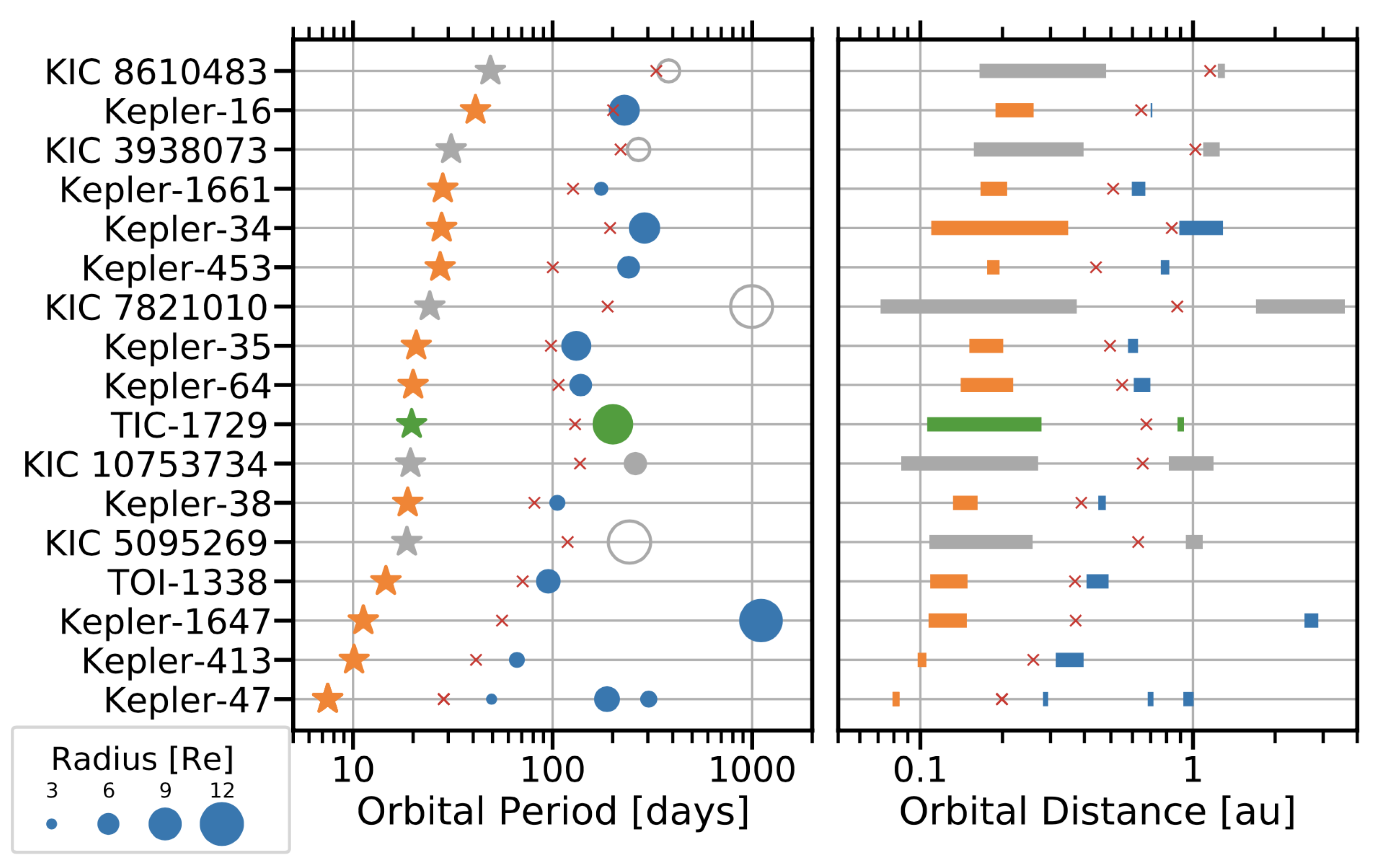
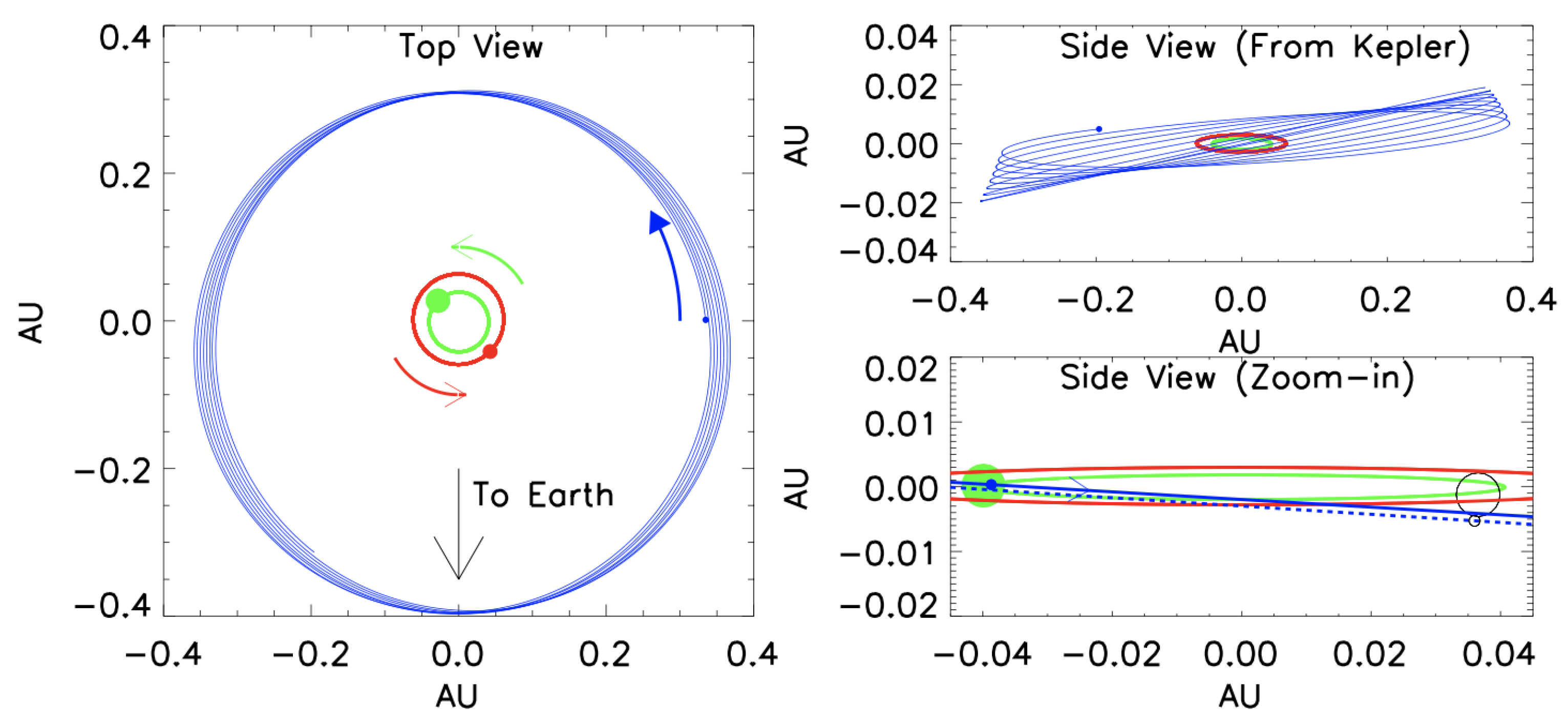
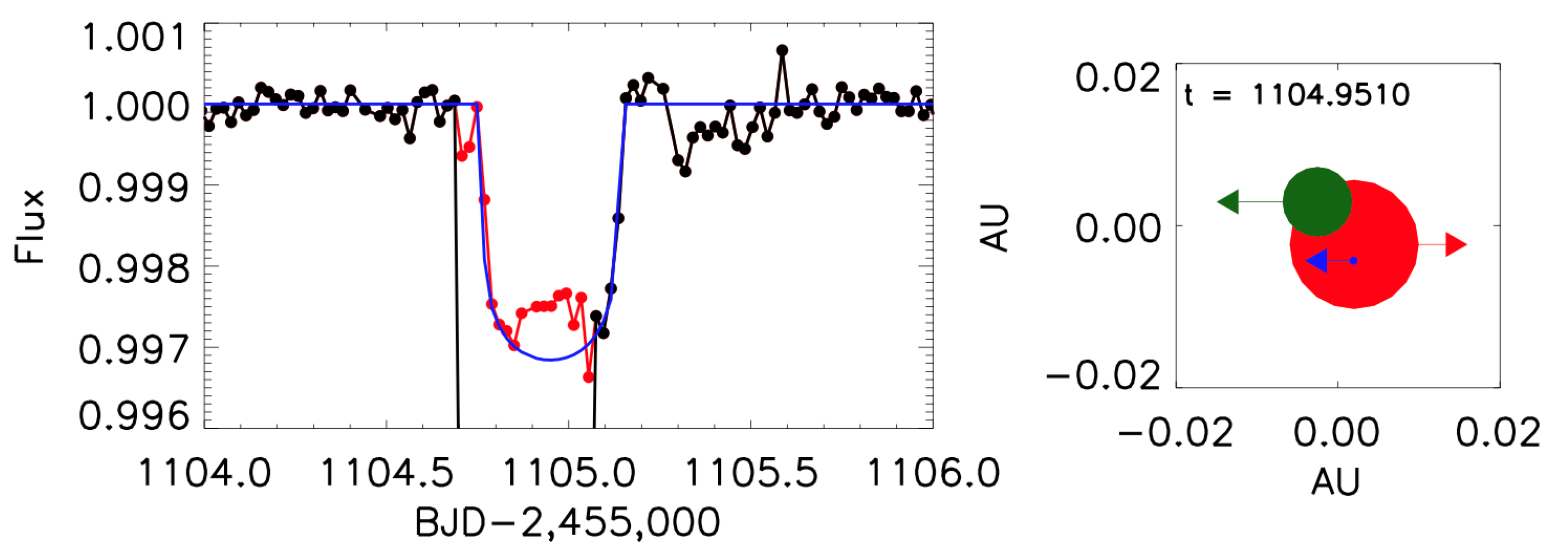
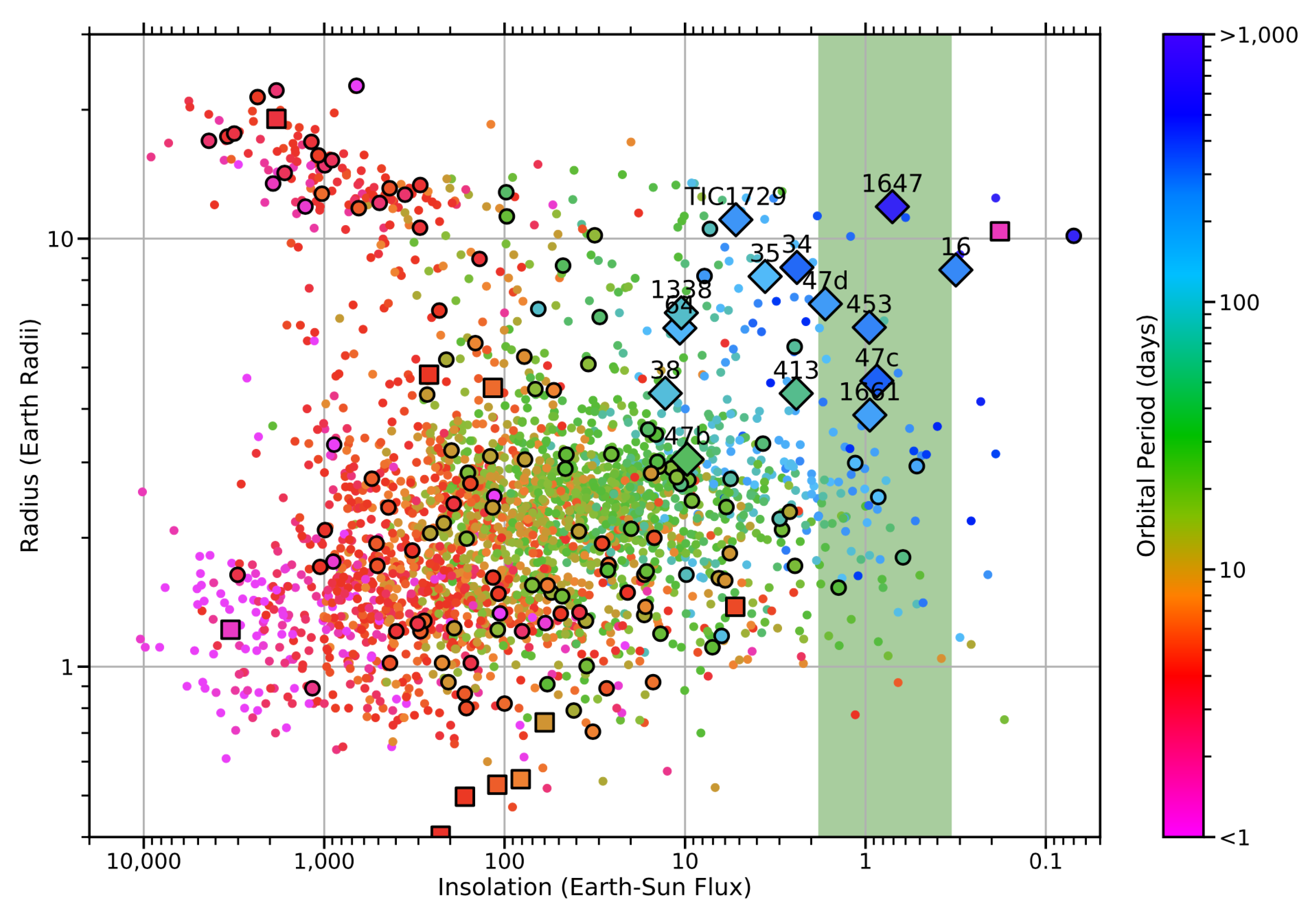


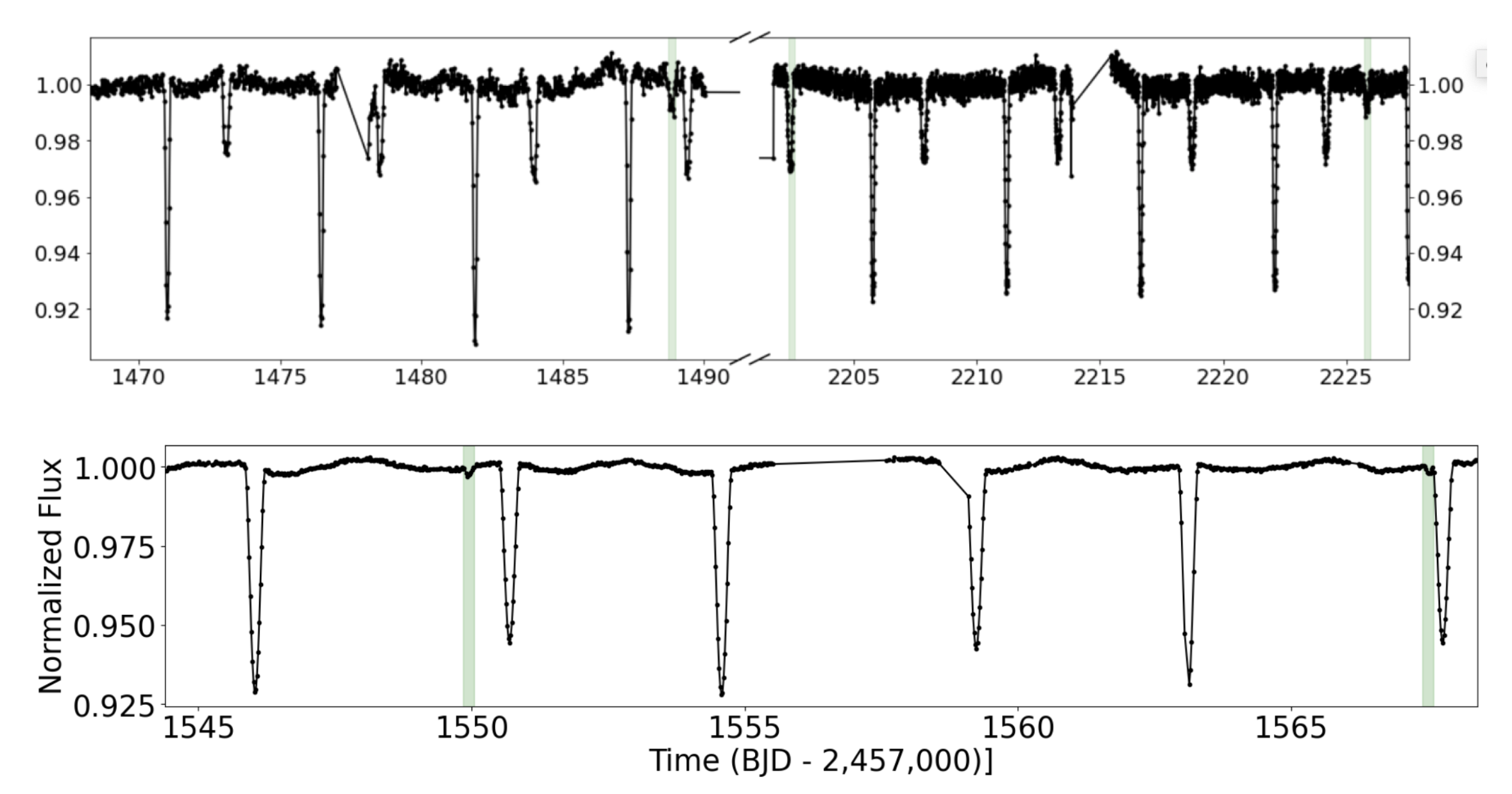
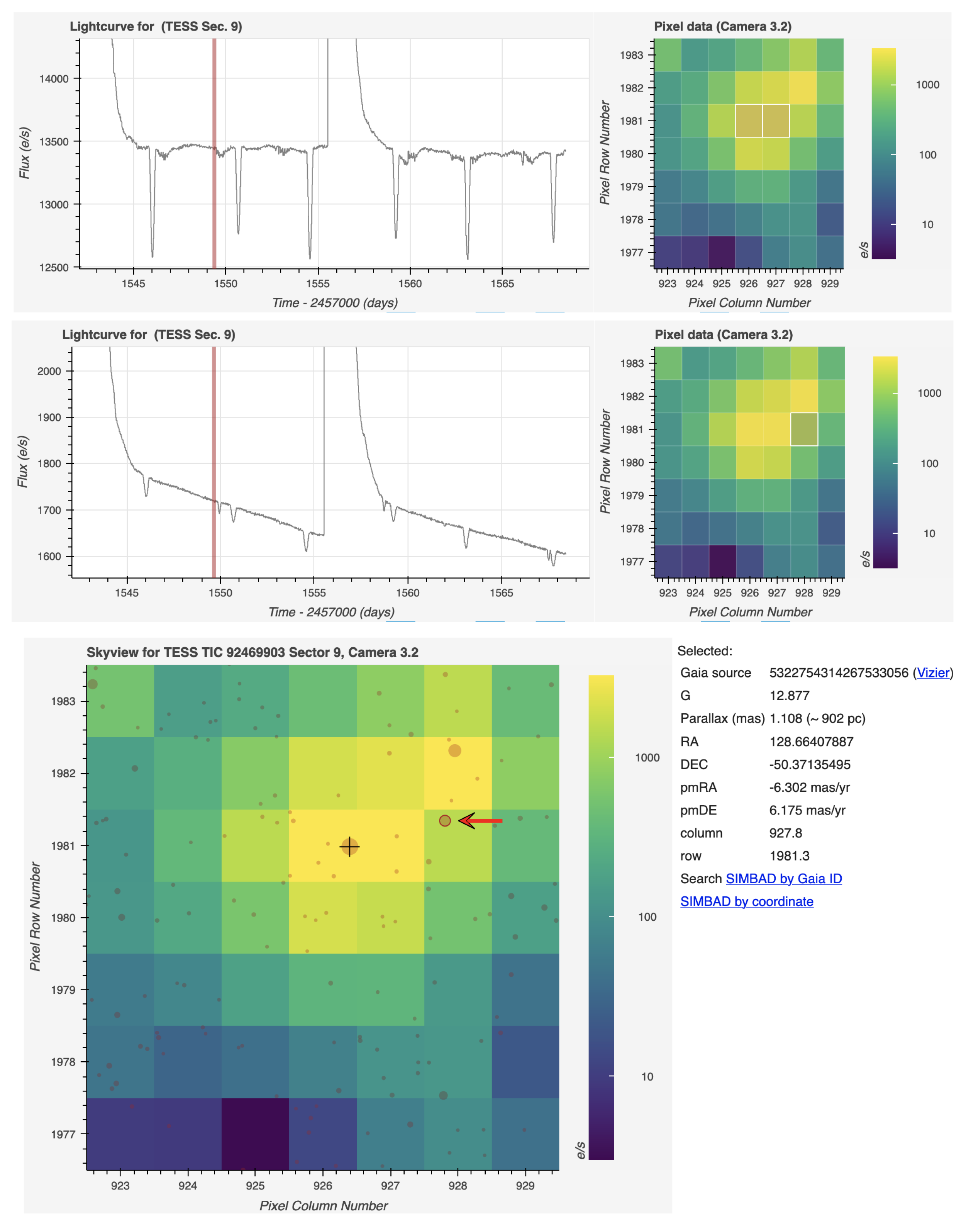
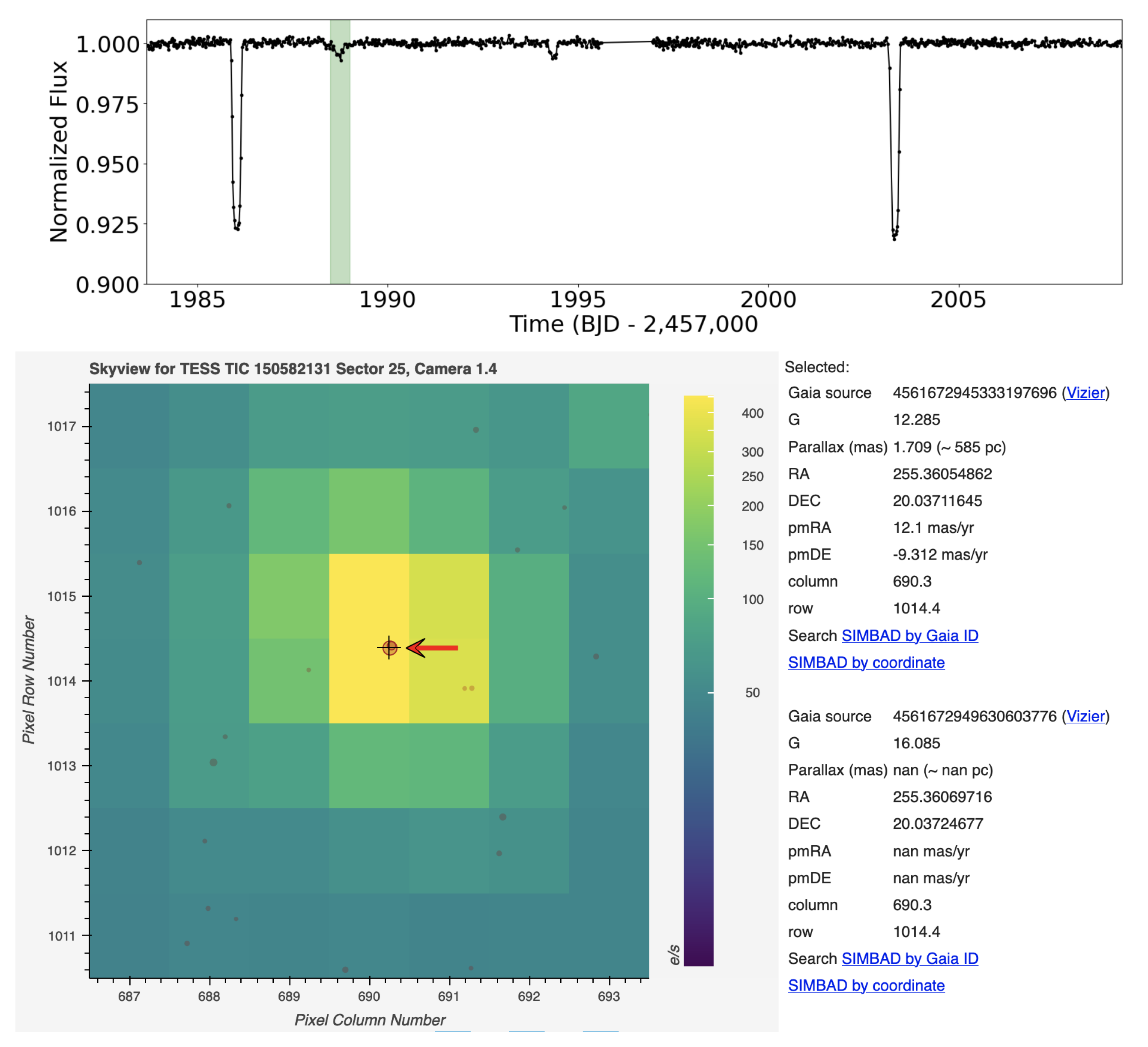
Disclaimer/Publisher’s Note: The statements, opinions and data contained in all publications are solely those of the individual author(s) and contributor(s) and not of MDPI and/or the editor(s). MDPI and/or the editor(s) disclaim responsibility for any injury to people or property resulting from any ideas, methods, instructions or products referred to in the content. |
© 2023 by the author. Licensee MDPI, Basel, Switzerland. This article is an open access article distributed under the terms and conditions of the Creative Commons Attribution (CC BY) license (https://creativecommons.org/licenses/by/4.0/).
Share and Cite
Kostov, V.B. Transiting Circumbinary Planets in the Era of Space-Based Photometric Surveys. Universe 2023, 9, 455. https://doi.org/10.3390/universe9100455
Kostov VB. Transiting Circumbinary Planets in the Era of Space-Based Photometric Surveys. Universe. 2023; 9(10):455. https://doi.org/10.3390/universe9100455
Chicago/Turabian StyleKostov, Veselin B. 2023. "Transiting Circumbinary Planets in the Era of Space-Based Photometric Surveys" Universe 9, no. 10: 455. https://doi.org/10.3390/universe9100455
APA StyleKostov, V. B. (2023). Transiting Circumbinary Planets in the Era of Space-Based Photometric Surveys. Universe, 9(10), 455. https://doi.org/10.3390/universe9100455





